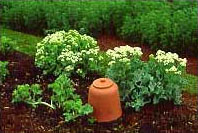 |
| It took 5,000 square feet of bluestone to create the labyrinth which is set in lush fescue. Photo by Dorothy Hong for WSJ. |
By Amy Gamerman
“All I asked for was just a little place to walk the walk,” said Ruth Ann Harnisch, a 65-year-old philanthropist.
What she got—after a massive, two-year earthwork project at her home in New York’s Hamptons—is an 86-foot tripartite path of hand-cut stone, set in lush fescue grass.
It took 5,000 square feet of North River bluestone to create the intricately winding walkway—called a labyrinth—which has 18 looping turns and is encircled by a 300-foot-long fieldstone wall. The pavers were set in dry-pack mortar on top of concrete wire mesh, to hold them in place. An underground irrigation system was installed to keep the grass bright and shaggy.
Thirteen mature Yoshino cherry trees, trucked into the site, ring the labyrinth. In the springtime, they shower its walkways with white blossoms. “It’s magical,” said Bill Harnisch, 69, president and CEO of Peconic Partners, an investment firm.
Labyrinths—circular paths for walking meditation that have been widely adapted by churches, hospitals and retreat centers—are now popping up in upscale American backyards. “There are 3,740 labyrinths in the U.S.—it’s really blossoming,” said Lauren Artress, author of “Walking a Sacred Path: Rediscovering the Labyrinth as a Spiritual Practice.” Some are simple, such as the 30-foot spiral of desert stones that Andrew Weil, the physician, author and founder of the University of Arizona Center for Integrative Medicine, built at his home in Tucson. Other, more lavish walkways evoke the 13th-century labyrinth of Chartres Cathedral in France.
See full article, video and slideshow of labyrinths built around the US at: http://www.wsj.com/articles/labyrinths-offer-homeowners-a-pathway-to-peace-1450364046





























